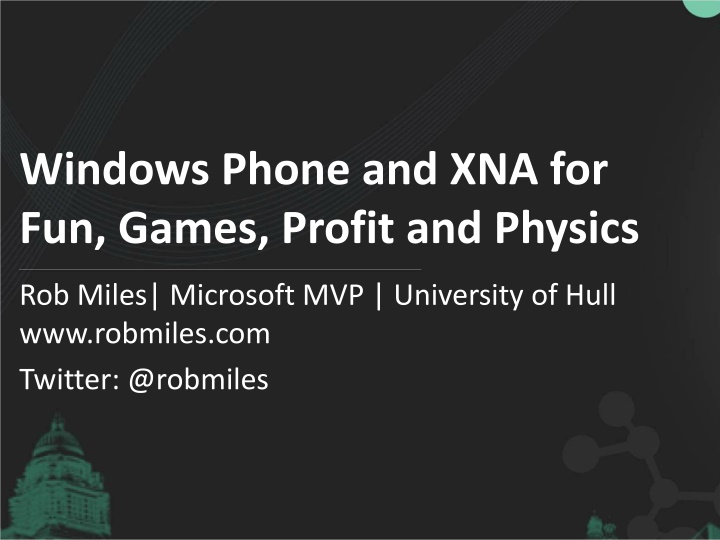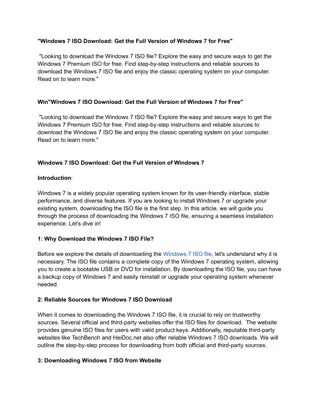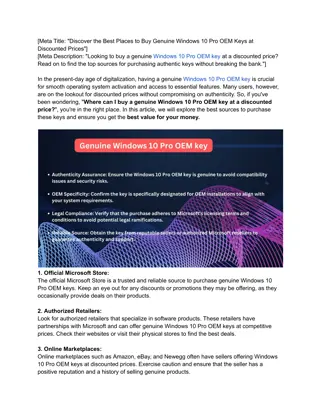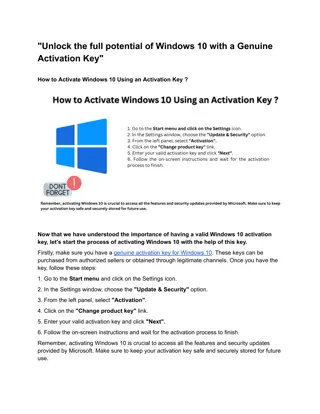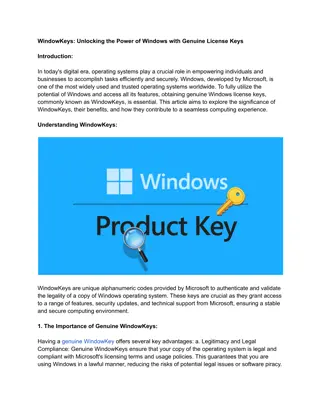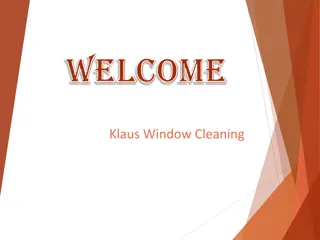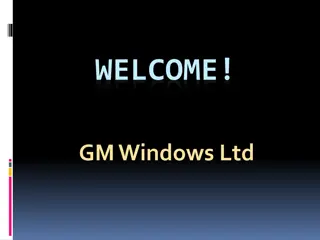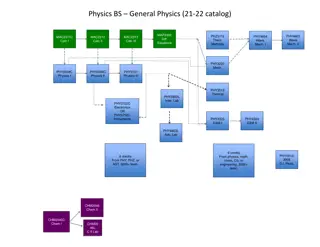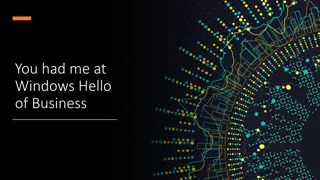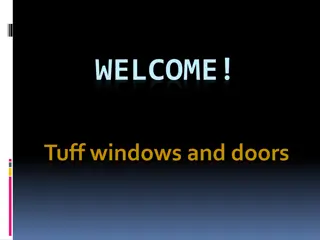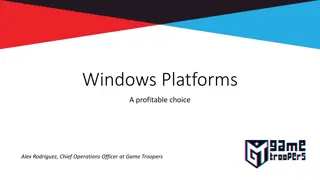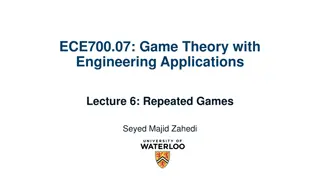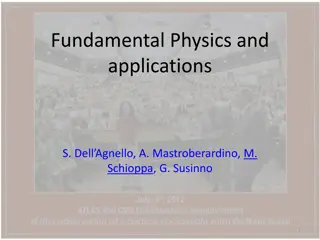Windows Phone XNA Games and Physics
Dive into the exciting world of Windows Phone game development with XNA! Learn how to create fun and profitable games, add physics elements, and leverage the device's unique features. Discover the essentials of XNA game development, explore game behaviors, and master key methods for creating engaging experiences. Follow along with a detailed agenda covering orientation, touch panel gestures, Farseer Physics Engine, accelerometer usage, and insights into the Windows Phone Marketplace. Get started by creating your own game project and embark on a creative journey into game development with this comprehensive guide by Rob Miles, a Microsoft MVP.
Download Presentation

Please find below an Image/Link to download the presentation.
The content on the website is provided AS IS for your information and personal use only. It may not be sold, licensed, or shared on other websites without obtaining consent from the author.If you encounter any issues during the download, it is possible that the publisher has removed the file from their server.
You are allowed to download the files provided on this website for personal or commercial use, subject to the condition that they are used lawfully. All files are the property of their respective owners.
The content on the website is provided AS IS for your information and personal use only. It may not be sold, licensed, or shared on other websites without obtaining consent from the author.
E N D
Presentation Transcript
Windows Phone and XNA for Fun, Games, Profit and Physics Rob Miles| Microsoft MVP | University of Hull www.robmiles.com Twitter: @robmiles
AGENDA Getting started with XNA Sorting out orientation Using the touch panel gesture support Adding a touch of Physics with the Farseer Physics Engine Using the Windows Phone accelerometer The Windows Phone Marketplace
QUICK OVERVIEW OF XNA The XNA Framework provides everything you need to get started writing games: Full Content Management (integrated into Visual Studio) Support for 2D Sprite-based gameplay Support for 3D games Common behaviours across the Windows PC, Xbox 360 and Windows Phone One game engine can run on all platforms Well factored object model
HOW GAMES WORK Every game that has ever been written has these fundamental behaviours: Initialise all the resources at the start fetch all textures, models, scripts etc Repeatedly run the game loop: Update the game world read the controllers, update the state and position of game elements Draw the game world render the game elements on the viewing device
METHODS IN AN XNA GAME The XNA Game class contains methods that will provide these behaviours Initialise all the resources at the start The Initialize and LoadContent methods Repeatedly run the game loop: Update the game world The Update method Draw the game world The Draw method
GETTING STARTED WITH XNA When you create a new XNA game project you are provided with empty versions of the game methods Creating an XNA game is a matter of filling in these methods to get the game behaviours that are required We are going to start by getting some cheese moving around the display Then we are going to start rolling it around to score points This is the latest cheese game in a long running series: Behold CHEESE ROLLER!
DEMO Demo 1: Drawing Cheese
WINDOWS PHONE AND ORIENTATION By default a Windows Phone XNA game assumes it is running in landscape mode with the screen on the left of the controls I want to change this, because I want to send the cheese down the long axis of the phone when it is rolled I can select orientation when the game starts
ORIENTATION AND DISPLAY // Tell XNA we can only support Portrait orientation // Can support a range of orientations by ORing // together orientation values graphics.SupportedOrientations = DisplayOrientation.Portrait; // Set up hardware scaling of the display area graphics.PreferredBackBufferWidth = 480; graphics.PreferredBackBufferHeight = 800; // Want a full screen display graphics.IsFullScreen = true;
ORIENTATION MANAGEMENT An XNA game can specify the orientations it can support The game can bind a method to the event which is fired when the orientation changes Games can animate the transition to the new orientation if they wish When orientation changes the origin for the draw position is moved to the top left hand corner of the viewport The frame of reference for accelerometer readings (of which more later) is always as for the phone held in portrait mode
SIZE AND THE SCALER An XNA game can also request a specific size of back buffer for the display The game will be given this resolution irrespective of the actual device The Graphics Processor (GPU) performs this scaling automatically and interpolates to remove any jagged edges This is a great way to get performance boost by rendering to a lower resolution than the screen itself In a fast moving game the lower resolution is not noticeable
DEMO Demo 2: Orientation and Scale
CREATING A GAME WORLD An XNA game uses a number of variables to represent the state of the game itself The Update method will update their values The Draw method will produce a display that reflects their value In the case of Cheese Roller the game must manage the position and movement of the cheese on the screen We use a Texture2D value and a Rectangle to hold the position and a Vector2 to give the direction of movement We also have a Friction value to slow the velocity over time
USING GESTURES We are going to use the touch panel to allow the player to flick the cheese around For the ultimate in control you can get direct access to touch events from the panel Up to four events can be tracked at one time Each event is uniquely identified throughout its lifetime However, XNA games can also use built in gesture recognition Register an interest in a particular gesture type and then get notification when one has been performed
SUPPORTED GESTURES The touch panel can detect a number of different gestures including Tap DoubleTap Hold HorizontalDrag, VerticalDrag and FreeDrag Pinch Flick The Cheese Roller game is going to use the Flick gesture
REGISTERING AN INTEREST IN A GESTURE TouchPanel.EnabledGestures = GestureType.Flick; The game must select those gestures that it wants to use This can be done once at the start of the game I do it in the XNA Initialise method A game can also query the TouchPanel about the number of points it can track simultaneously
RETRIEVING GESTURES while (TouchPanel.IsGestureAvailable) { GestureSample gesture = TouchPanel.ReadGesture(); if (gesture.GestureType == GestureType.Flick) cheeseSpeed = Vector2.Divide(gesture.Delta, 100); } The Flick gesture returns a Delta value which gives the speed of the flick The divide factor of 100 is something I came up with by playtesting The smaller the value, the more powerful the effect of the flick
DEMO Demo 3: Rolling Cheese
IMPROVING CHEESE ROLLER The obvious improvement to Cheese Roller is to add more cheese If we do this the physics becomes more complicated Our simple model can no longer cope with all the collisions Fortunately there are a lot of engines out there that can help One of these is the Farseer engine It is a 2D physics engine that is very easy to use and works well on Windows Phone
THE FARSEER PHYSICS ENGINE The FarSeer Physics Engine is a Codeplex based project you can download from here: http://farseerphysics.codeplex.com/ Version 3.0 has just been released but there is not a version of this that is suitable for Windows Phone just yet I have used Version 2.0 for my Windows Phone Destruction Golf game
FARSEER OBJECTS Objects in the Farseer 2.n universe are made up of a Body and a Geometry We create instances of these and add them to the Farseer simulator When the XNA game updates we also update the simulator so that it moves the objects around We create the simulator at the start of the program
THE SIMULATOR //The physics simulator is always needed. // We supply a gravity of 250 units PhysicsSimulator simulator = new PhysicsSimulator(new Vector2(0, 250)); When we create the simulator we also give it a vector that indicates the direction of gravity A vector is a way of expressing a direction We can create it by giving it x and y direction values We can change this to make gravity work in any direction we like, or with any amount of strength, which might be fun
THE SHELF DATA /// <summary> /// Texture of the shelf the target sits on /// </summary> Texture2D shelfTexture; Body shelfBody; Geom shelfGeom; Vector2 shelfOrigin; The shelf is the simplest object on the screen It has a texture that is used to draw it, a Farseer body and a Farseer geometry It also has an origin value, which is the centre of the object
THE SHELF BODY shelfTexture = Content.Load<Texture2D>(@"images\shelf"); shelfOrigin = new Vector2(shelfTexture.Width / 2.0f, shelfTexture.Height / 2.0f); shelfBody = BodyFactory.Instance.CreateRectangleBody( shelfTexture.Width, shelfTexture.Height, 1); shelfBody.IsStatic = true; shelfBody.Position = new Vector2(550, 400); simulator.Add(shelfBody); This creates a shelf body and places it in the world Note that I ve scaled the texture to fit the display world I have also made the shelf static, so that it can t move around in the world
THE SHELF GEOMETRY shelfGeom = GeomFactory.Instance.CreateRectangleGeom(shelfBody, shelfTexture.Width, shelfTexture.Height); shelfGeom.RestitutionCoefficient = 0.3f; shelfGeom.FrictionCoefficient = 0.5f; simulator.Add(shelfGeom); This creates a shelf geometry and places it in the world This sets out how much bounce (RestitutionCoefficient) we get from the shelf and how slippery (FrictionCoefficient) we want it to be Playing with these values is fun
DRAWING THE SHELF spriteBatch.Draw(shelfTexture, shelfGeom.Position, null, Color.White, shelfGeom.Rotation, shelfOrigin, 1, SpriteEffects.None, 1); We use a more advanced version of the Draw method that lets us specify a rotation value for the texture The shelf won t rotate, but other objects will Note that we get these values out of the geometry for the shape The draw operations for all the game objects look the same
THE TARGET DATA The target is the house we are aiming at It has the same information stored about it as the shelf We will place the target on the shelf when the game starts The only difference between the target and the shelf is that the target is allowed to move The aim of the game is to knock the target off the shelf
THE TARGET MASS targetBody = BodyFactory.Instance.CreateRectangleBody( targetTexture.Width, targetTexture.Height, 3); Bodies in Farseer are given mass The higher the mass the harder they are to get moving, and the more damage they do when they hit The mass of the shelf is not an issue, since it is fixed in position I ve given the target a mass of 3 This is a value you might want to fine tune
BALL POSITION ballGeom = GeomFactory.Instance.CreateCircleGeom(ballBody, ballTexture.Width/2, 50); ballGeom.RestitutionCoefficient = 0.3f; ballGeom.FrictionCoefficient = 0.5f; The ball geometry is based on a circle rather than a rectangle When create a circle you give the radius and the number of edges This is because the circle is actually an approximation The more edges, the more accurate the approximation but the more work it is to calculate
BALL LAUNCHING while (TouchPanel.IsGestureAvailable) { GestureSample gesture = TouchPanel.ReadGesture(); if (gesture.GestureType == GestureType.Flick) { ballBody.ApplyImpulse(Vector2.Divide(gesture.Delta, 1.5f)); } } We use Windows Phone gesture support to fire the ball The Flick gesture provides a Delta vector that we apply as an impulse to the ball object
DETECTING COLLISIONS ballGeom.OnCollision += new CollisionEventHandler(ballHits); Farseer will detect collisions for us We can bind an event handler to the collision event When the collision occurs the handler method is called automatically The above code binds a method to the collision event
COLLISION HANDLER bool ballHits(Geom geometry1, Geom geometry2, ContactList contactList) { if (ballSoundActive) return true; if (geometry1 == shelfGeom || geometry2 == shelfGeom) return true; ballSoundActive = true; bangSound.Play(); return true; } Called whenever a collision is detected Checks to see if the ball has hit the shelf or the target
COLLISION HANDLER SOUND MANAGEMENT bool ballHits(Geom geometry1, Geom geometry2, ContactList contactList) { if (ballSoundActive) return true; if (geometry1 == shelfGeom || geometry2 == shelfGeom) return true; ballSoundActive = true; bangSound.Play(); return true; } Only plays the sound if the ball has hit the house Only plays the sound once
UPDATING FARSEER simulator.Update(gameTime.ElapsedGameTime.Milliseconds * .0005f); We need to add this method call to the Update method to keep the Farseer simulation running The time factor controls the rate at which the engine updates You can tune this if you have problems with items moving so fast they go inside or through each other For the purpose of my program the value above works fine
SCROLLING BACKGROUND if (ballGeom.Position.X + scrollMargin > width) { // need to scroll the screen xOffset = width - (ballGeom.Position.X + scrollMargin); } We use a transformation matrix for the draw operation so that we can scroll the screen to follow the ball We can get the position out of the ball geometry so our program can tell where the ball is
TRANSFORMATION MATRIX Matrix transformation; transformation = Matrix.CreateTranslation(xOffset, 0, 0); A transformation matrix is a lump of maths that can be applied to a drawing operation to change the way it looks Scaling Rotation Translation We just want to translate our view when we draw it XNA will create a translation matrix for us
DRAWING WITH A TRANSFORMATION MATRIX spriteBatch.Begin(SpriteSortMode.Immediate, null, null, null, null, null, transformation); // transformed drawing spriteBatch.End(); We can ask SpriteBatch to use this matrix to transform the drawing operation All the drawing performed will be moved according to the matrix supplied We can follow this with an untransformed draw if we wish
DEMO Demo 4: Destruction Golf
USING THE PHONE ACCELEROMETER You can also use the accelerometer to control the behaviour of objects in your game The Accelerometer can measure acceleration in X, Y and Z You can use just the X and Y values to turn it into a replacement for a gamepad The values that are returned are in the same range -1 to +1 in each axis
ADDING THE SENSORS LIBRARY The reason why the accelerometer is event driven is that XNA actually uses the same sensor interface as Silverlight This means that you need to include the appropriate sensor library into your program to obtain accelerometer readings You need to add Microsoft.Devices.Sensors to your solution to bring in the library
XNA 4.0 Accelerometer Unlike other XNA input devices the accelerometer in XNA 4.0 is event driven The accelerometer generates events when new readings are available You must bind a method to the event The method can store the settings for later use
CREATING AN ACCELEROMETER Accelerometer accel = new Accelerometer(); accel.ReadingChanged += new EventHandler<AccelerometerReadingEventArgs> (accel_ReadingChanged); accel.Start(); The above code runs in the Initialise method to set up the accelerometer It creates a new Accelerometer, binds an event handler to it and then starts it running
READING THE ACCELEROMETER object accelLock = new object(); void accel_ReadingChanged(object sender, AccelerometerReadingEventArgs e) { lock (accelLock) { accelReading.X = (float)e.X; accelReading.Y = (float)e.Y; accelReading.Z = (float)e.Z; } }
USING THE ACCELEROMETER lock (accelLock) { cheeseAcceleration.X = accelReading.X * acceleratorPower; cheeseAcceleration.Y = -accelReading.Y * acceleratorPower; } This code uses the accelerometer values stored by the event handler to manage the cheese movement Note that I use a lock to stop the event handler and the Update method from fighting over the values
TIPPING GAMES The accelerometer makes it very easy to create tipping games, which simulate gravity moving items around the screen The further you tip the device the greater the force acting on the object We could use the accelerometer values as forces that drive the Farseer physics engine directly
DEMO Demo 5: Cheese Lander
Games and Applications Programs are loaded onto the phone from the Marketplace over the air (WiFi or 3G) or via the Zune application This is the only way to put programs on a locked device Registered developers can unlock a device for testing
Joining the Marketplace If you want to take your games to market you will need to join the Windows Phone Marketplace as a developer This is managed via your Windows Live identity It costs $99 per year Students can get free membership via DreamSpark Joining the Marketplace lets you publish games and unlock Windows Phone devices for testing Developers can unlock up to three devices Students can unlock just one
Free and Trial Applications You can give away up to 100 applications each year you are member of the Marketplace Any further free applications will cost $20 each for validation You can also make available trial versions of a game or application Customers can purchase an upgrade from within the application
Submitting Applications You are guided through the submission process for your application The application itself is submitted as a single xap file This is an archive with a manifest which is generated by Visual Studio when the game is built It contains all the game content and resources
